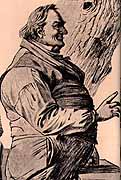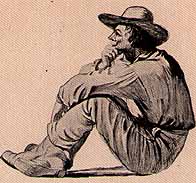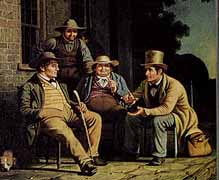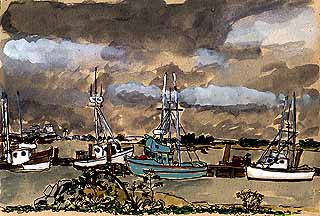American Sabbatical 039: 10/25/96
EUREKA
10/25..Eureka.

Stump Speech
(Geo. Caleb Bingham)
|
Now we’re out of state and the thought police can’t grab us, I’ll pass along a few observations
about Oregon. It used to be that California was our future, but,
for Mainers at least, Orygun may come closer to prophecy. These
are the folks who brought back bottle deposits, after all. We
knew we were on familiar turf once we picked up the Daily Oregonian
and read the referenda rantings. There are 23 citizen-intiated
measures on this year’s ballot. To keep her voters informed, Mother
OR has printed two 2-hundred-page booklets giving full text of
the measures, a readable translation, their financial impact,
and discussions pro-and-con, supplied by interested (paying) parties.
Astonishing documents. Any interested voter can request them,
and 634,000 residents have gotten copies postpaid! |
| There’s greenstuff, redneck stuff, bureaucratese, anti-taxism,
the whole megillah. And the level of rhetoric is right up there
with the BAN or NOT TO BAN clearcutting chatter in ME. We heard
one ad on AM talk radio which warned about the impact of a predator-protection
measure. The ad warned there will be livestock kills, abolition
of hunting rights, the state will be turned into a game reserve
with passes required to enter, and mountain lions will come into
the schoolyard to eat your kids. Just the usual cool, clearheaded
political discussion. If Oregon is a clue, a proliferation of
initiatives will be a boon for the printers and the bureaucrats..
and the talkshow hosts. Ah, government. |

Voter
(Bingham)
|

Working the hustings
(Bingham)
|
You may have noticed that the above indicates we have radio reception
in the Owl again. Apparently it had something to do with a near-Terry
approach. I reported how Terry had helped conjure up a metaphysical
radioman in darkest Newfoundland (I said in 1968, but he says
67).. the wily R.F.Suruk. We’d blame R.F. for all our outages
at the transmitter site. Is it just coincidence, then, that our
radio breaks down suddenly as we approach within 200 miles of
Terry, and just as suddenly starts working again 200 miles south?
Not on your Suruk. This guy is a walking deep sink. Spacecraft
take notice.. plumbers, too. (I should add that getting reception
back was partly the result of prayer. At least I said aloud, “It
would be nice to have the radio working,” and turned it on.. to
talk AM. Heavenly.)
|
Another facet of the Orygun experience is the weird hat syndrome.
I have to feel at home in a place where there are so many longhairs,
bearded ones, and peculiar headgear. And hitch-hikers. Maybe that’s
why half the population is still driving microbusses, to pick
up the others, and their dogs. We can thank the wisdom of Maine’s
Dept. of Transportation for precluding this possible future by
pouring enough salt on the roads to rust out all those old vans
(and kill the roadside pines).
So: is the future possible? You’ll have to read your ballot carefully
to judge. We got out of state before they turned the wildcats
loose.
We’re camped at this motel in Eureka for the weekend. It’s nice
to set in one place for a spell without feeling you are imposing
on the hospitality of friends.. of course the jacuzzi and the
sauna have nothing to do with it. When we called our friend David,
he proposed we meet at this little restaurant that has great spinach
pie. We laughed. When we got there he was sitting in “our” booth.
Tell me there aren’t ruts in the air all our balls are rolling
in.
David is a genial giant, all 500 pounds of him. The kind of guy
who drinks his beer by the pitcherful, and looks at the furniture
carefully. He’s a reporter for the local rag in Eureka/Arcata,
and can stop on every streetcorner to tell you a tale about it.
We first met when he was reporting for the Lewiston (Maine) paper,
and did a story on Bryce the Toymaker, and we’ve stayed in touch.
Like most old news-hounds he’s a wellspring of lore and an irrepressible
raconteur. We’ve put ourselves in his hands for the next few days,
and the Owl is sleeping at Super-8. Tell you more manana.

Fleet at Arcata
(Memo #35)
|
Oct. 25 - Gum san (the mountain of gold)
Who? Chinese immigrants
What? laborers in many niches during coastal boom
Where? northern California and throughout west
When? immigration beginning in the 1780's (possibly as early as
499 a.d.) to Eureka in 1850
How? persevered despite discrimination - expelled from Eureka
1874
Topics: California settlement, ethnicity, Chinese immigration,
railroads, early Civil Rights movement.
Questions: What brought different groups to the West Coast? What
economic niches did they fill? What conditions and attitudes did
they face? What laws were passed that affected Chinese immigrants?
Do our images include the Chinese miner and shrimp fisherman? |
|
My sister-in-law is Chinese-American. She is (I think) the sixth
generation in her family to live in this country. Her greatgreatgreat
grandmother was one of the first small group of Chinese women
allowed in. I am first generation American; my father immigrated
from eastern Europe at the age of three. Yet my sister-in-law
may be asked how long she’s been here, while I never am, and there
is continued stereotyping of Asian-Americans.
At the small Clarke Museum in downtown Eureka, I saw an exhibit
called “Gum San” (Chinese for “Golden Mountain”- as they called
California) which detailed Chinese immigration to the west coast
and their history in the United States in photos and artifacts.
It’s a long and complex history. Most people know the part the
Chinese played in the building of the transcontinental railroad
and have toured the Chinatown section of major cities. The Chinese
may have voyaged across the Pacific to North America as early
as 499 a.d. (1100 years before Columbus) when Chinese records
detail the trip of a monk named Huishen who traveled 7000 miles
east to a land he called Fusang. This is much like the legends
of western travel that surround the Irish monk St. Brendan the
Navigator.
Chinese people came to the United States in the 1780s: three Chinese
arrived in Baltimore on a trade vessel in 1785 and thirty Chinese
workers came to Nootka Sound, B.C., in 1788. The rush of immigration
to the west coast came after 1850. There were both “push” and
“pull” factors. The “push” factors which drove thousands of people
from southern China were the failing economy, fast population
growth, and civil war in Guandong (one estimate is that 20-40
million Chinese died in social unrest between 1851-65). At the
same time the “pull” factor was the need for workers on the west
coast created by the Gold Rush and the quick development of California.
By 1852, over 30,000 Chinese - almost entirely men - had sailed
from Hong Kong to San Francisco. The Chinese were 25 percent of
the unskilled labor but only ten percent of the California population
in 1870. In the 1880’s Chinese were 75% of the seasonal workers
in California agriculture. Between 1876 and 1890, over 200,000
more Chinese immigrated . Many came on credit, working off the
cost of their passage after they arrived (a $50 ticket would ultimately
cost $120 and many people were debt slaves for decades). Right
from the beginning there were laws that limited Chinese naturalization
and rights.
The Chinese moved into many economic niches; by 1870 most miners
were Chinese (gold, quicksilver, borax). They worked on the railroads
and in the garment and laundry businesses, they rolled cigars,
grew crops, canned salmon, drained and diked swamps. They developed
the abalone and shrimp industries. They moved far inland; I saw
pictures of Chinese chuckwagon cooks on cattle drives and Chinese
merchants in Utah. Apparently the early Chinese immigrants spread
out through the West, but the population became more centralized
in major cities in the late nineteenth century. The Chinese often
worked in all-Chinese crews that were recruited and run by Chinese
labor bosses. This was the pattern on the railroads. Amy Tan talks
of an ancestor on a railroad crew who was lowered over the cliffs
in a basket to set dynamite charges (the Chinese were considered
ideal for this dangerous job because they were lighter and smaller
than most Anglos). A Chinese crew set the railroad building record
of ten miles of track laid in 10 hours!
The Chinese brought with them new customs, new food, a new language
and religion. There was resentment and fear of them as a “yellow
peril”. Laws limiting their rights were written as early as 1852.
In 1882 Congress passed the Chinese Exclusion Act which forbade
entry of Chinese worker to the United States for ten years, This
was the first legislation barring immigration based on ethnicity.
The ban was extended indefinitely in 1904. Fear of Chinese immigrants
lead to the passage of a variety of laws that limited their rights
- laws making marriage with whites illegal, laws banning Chinese
children from school, laws limiting land ownership. The Chinese
fought these laws in an early civil rights movement testing the
fourteenth amendment. and in more recent actions. Laws were overturned.
Recent newspaper stories about Chinese representation in higher
education seem to show continuing ambivalence about Chinese-Americans.
In early California resentment of Chinese sometimes resulted in
violence. Here in Humboldt County, the first Chinese arrived in
1850 and by 1874 there were 200 Chinese living in downtown Eureka.
In a famous local incident, after a Chinese man killed a white
man (self-defense?), a scaffold was erected in the middle of town
by a mob with a sign: "Any Chinamen seen on the street after three
o’clock will be hung on this gallows." A local minister helped
prevent a massacre, but the Chinese population was rounded up
and sent to San Francisco and there was no Chinese population
in Eureka for decades. Today there are several Chinese restaurants
visible as you drive through town .
The exhibit had photographs of every phase of Chinese-American
history - workers in the fields and canneries, house servants,
businessmen, religious processions. The cases had Chinese clothing
and artifacts from abacuses for businessmen to games. There are
many sites in the West connected with Chinese history from a Chinese
cemetery in Walla Walla to a Joss House in Weaverville, Ca. The
big Chinatowns also have Chinese cultural centers and museums.



